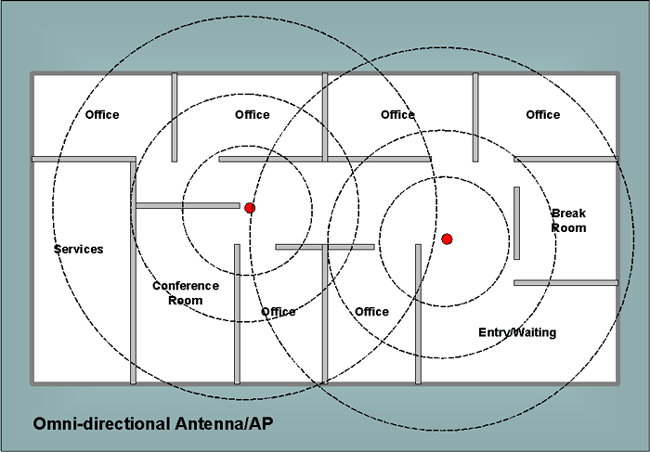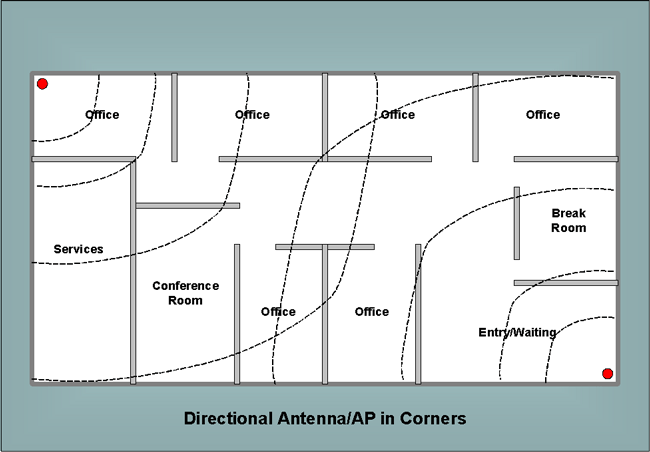| It is also the case that each "radio
transceiver" on
an AP is set to a particular channel/frequency. As we
will also see, it is important to make sure that different
APs are configured for particular channel. So this
implies that the capacity of any given AP is really much
less than the theoretical capacity. I find these sorts
of things disturbing in that it seems that the information
we are given isn't as accurate as it should be. It is
often very hard to get realistic specifications!
Channels.
So now that we have possibly dismayed you about some of the
differences between reality and advertising, we still need
to deal with reality. Most authors, at least those
that I respect state things like the following.
User groups on separate access points
within a wireless LAN must be supported on separate and
distinct channels. This is even more true for
places where there is overlap between different APs.
We need some additional concepts.
adjacent
channel spacing or
active channel separation - this is the
amount of space between contiguous or active channels
from a design perspective the quality
and reliability of a wireless network is best when
channels assigned to access points that overlap are
selected from opposite ends of the spectrum
cochannel
interference is a RF
- radio frequency condition where channels
within the same wireless spectrum interfere with one
another
Cochannel interference can cause a
client's service session to lock up. It might also
cause severe network failure or total network collapse.
Thus it seems important to operate APs with overlaps on
different channels and the further apart the better.
Now that you know how CSMA/CA operates in
wireless and you know about channels and some basic
properties of intelligent implementation, what do you think
about the bandwidth at any given AP?
It is also the case that each "radio
transceiver" on an
AP is set to a particular channel/frequency. As we will
also see, it is important to make sure that different APs
are configured for particular channel. So this implies that
the capacity of any given AP is really much less than the
theoretical capacity. I find these sorts of things
disturbing in that it seems that the information we are
given isn't as accurate as it should be. It is often very
hard to get realistic specifications!Radios/Antennas.
I need to spend some time discussing characteristics of
radio transceivers/antennas. The terms can be used interchangeably,
though usually not with the exactitude they should.
It is usually the case that an AP is
associated with a particular radio transceiver and radio channel. The
antennas are generally attached. But there are plenty of
models where a card is inserted and an antenna is wired in
so that the antenna can be placed at least a few feet away
from the AP. The most typical devices I've seen for this
allow for two such independent radio transceivers/antennas. My
impression is this is why they talk about APs having more
than one radio transceiver, in order to distinguish their capability to
operate on a different channel on each antenna.
It is also my understanding that why some
802.11g APs advertise they give 108Mbps is they make use of
two active radio transceivers, each on their own channel. One of these
is focused on sending and the other on receiving. This
essentially doubles the capacity. But it still is
channelized! One must also be even more careful to have
appropriately distinct channel frequencies. Though, this is
much easier to do using the 802.11g specifications.
How many users should be configured on a
supporting radio transceiver? This is generally considered to depend on
the distribution system capacity. Since almost all wireless
APs uplink to a wired Ethernet, we will discuss the two
likeliest scenarios.
- uplink to a 10Mbps wired Ethernet
- most designers suggest a
maximum of 20 users configured to use a radio
transceiver
- obviously this depends on the
type of traffic and business of the wired
network
- uplink to a 100Mbps wired
Ethernet (switched or not)
- most designers suggest a
maximum of 40 users configured to use a radio
transceiver
- this seems high to me
considering specs on wired Ethernet and
extra limitations of wireless
- personally, I wouldn't
want to make much use of a system that was
very busy in this situation
- obviously this depends on the
type of traffic and business of the wired
network
- obviously this depends on the
size of the collision domains in the wired
network and where switches are used to improve
capacity
While there are more types of antenna than
I am going to present we will consider three basic
categories.
- direct
- area directed
- omni-directional spread/broadcast
The first diagram below relates to the use
of omni-directional antennas. |

